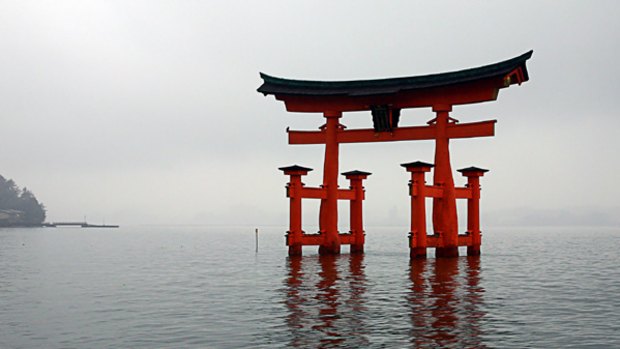
Holy site ... the revered O-torii Gate at Miyajima, the largest of its kind in Japan, stands amid the fog in tidal water.Credit: Ben Hall
Within minutes, the tide line covering the base of the torii gate drains outwards and scores of day trippers head down the stairs and walk across to the structure that dominates the skyline. At this time of day there's only a short window at low tide to be able to walk out and touch one of the most revered structures in Japan – the O-torii Gate at Miyajima.
Standing 16 metres, it's the largest torii gate in Japan and stands sentinel over the island and its other attraction, the Itsukushima Shrine, also built over the water.
Wild deer follow people down into the bay and they join the scene and mingle among the happy snappers who patiently take turns at photographing the torii gate close up.
The gate is the centrepiece of a small, mountainous island revered as a holy place for more than 1400 years. Today, more than a dozen temples and shrines, along with scores of pagodas and historical buildings, occupy the 20 square kilometres of Miyajima and are connected by a series of serene walking trails.
The Itsukushima Shrine is believed to have been built in 593, with shrine pavilions constructed in 1168. It's built in a small inlet, about a 10-minute walk from the ferry terminal in the main town, and has multiple buildings including a prayer hall, main hall and theatre stage, each connected by boardwalks over the sea. The temple was designated a UNESCO World Heritage Site in 1996.
The O-torii Gate, or Grand Gate, is a further 200 metres out in the Seto Inland Sea. Together the sites were designated as one of the "top three views in Japan" by the scholar Hayashi Razan in 1643.
While officially called Itsukushima, the island itself is more commonly referred to as Miyajima, which translates to Shrine Island, on which also stands the Daisho-in Temple. It is less visited, even though it's only a five-minute walk from Itsukushima Shrine, and is regarded as one of the most prestigious Shingon Buddhist temples in Japan. As with most temple and shrine complexes, on Miyajima there are multiple buildings and halls displaying ancient statues and artefacts but the most uplifting experience is to simply relax and enjoy the tranquil atmosphere of the grounds.
From Daisho-in, a hiking trail leads to the summit of Mount Misen at a height of just over 500 metres and the reward for the 1-hour hike is not just a great view but more ancient temples and walking trails at the summit.
Most visitors tend to stick to the lower levels near the sea, where the Goju-no-to Pagoda, or Five-Storied Pagoda, towers 27 metres over the main town. The pagoda was built in 1407 and is used to enshrine a Buddhist statue.
The main town itself stretches along the waterfront from the ferry terminal to Itsukushima Shrine and is a throwback to the Japanese Edo era, which is rare in modern-day Japan. The local government has ensured the town retains its classical look with restrictions on construction and renovations.
The wild deer also wander into town looking for handouts. Their favourite trick is to "pickpocket" tourists when they have their backs turned – they'll happily snuffle into a back pocket and eat whatever is inside, including wallets and handkerchiefs.
The deer love to hang out on the waterfront where there are a series of restaurants. These are a little pricey but a block or two back are some more authentic eateries and shops. Along the Omotesando shopping arcade, which is one street back from the sea, local vendors barbecue oysters (a local delicacy) while traditional tea joints and souvenir shops compete for tourist trade.
Most visitors to Miyajima are day trippers, often in tour groups, and after about 5pm they often disappear and the island takes on an even more serene atmosphere. This is where staying in a ryokan can offer an unforgettable cultural experience. After the crowds have gone, you join the locals who turn out for the lighting of the lanterns at sunset, dressed in a yukata, or traditional gown, and slippers.
TRIP NOTES
GETTING THERE
Japan Airlines flies daily from Sydney to Tokyo, from $1479 return. Phone 1300 525 287, see au.jal.com/en.
From Tokyo take the JR Tokaido-Sanyo Shinkansen Line to Hiroshima Station (takes about four hours), then connect to Miyajima-guchi Station on the JR Sanyo Line (25 minutes). The ferry station is about a five-minute walk from the station. A ferry ride takes 10 minutes to reach Miyajima.
WHERE TO STAY
Benten no Yado Itsukushima, 634 Miyajima-cho, Hatsukaichi-shi, Hiroshima. Phone 0011 (81) 829 44 2121, see bentennoyado.com/english
FURTHER INFORMATION
See Japan National Tourism Organization, jnto.org.au.
Sign up for the Traveller Deals newsletter
Get exclusive travel deals delivered straight to your inbox. Sign up now.